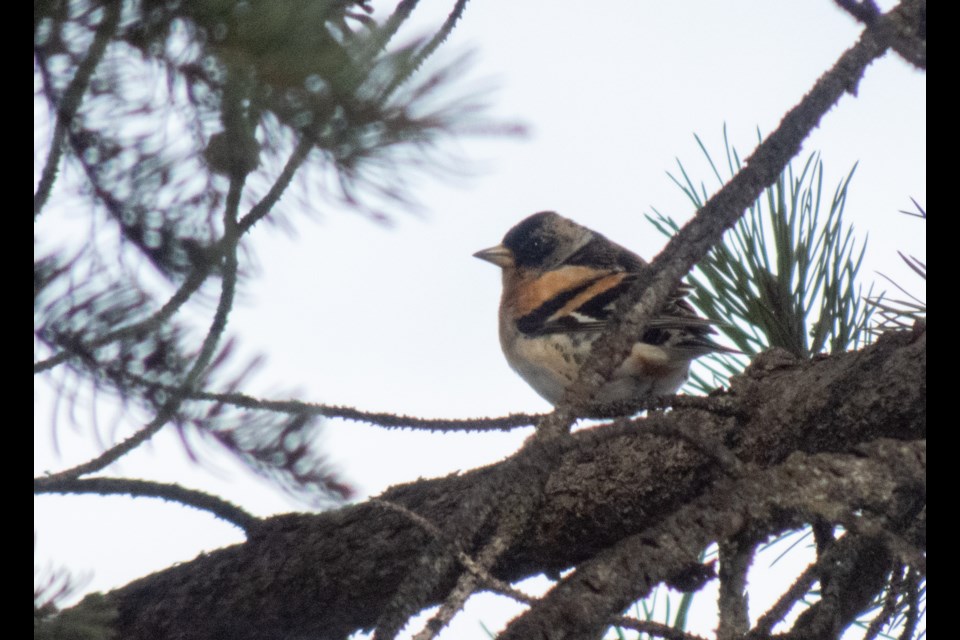LAKE LOUISE – A rare bird sighting in Lake Louise is causing quite a flap.
Last week, Lake Louise resident Anna Elkins spotted a brambling – a species in the finch family most common in Scandinavia and Russia but spreading across most of Europe and Asia as well – in the Banff National Park hamlet in what is only the seventh reported sighting of the species in Alberta.
“I've had a few rare bird sightings in the past, but nothing like this,” said Elkins, who has been an avid birder for about eight years.
“It’s a place I walk by hundreds of times and could never imagine seeing something like that.”
The first Canadian record of a brambling was Feb. 7, 1971, at Haida Gwaii in British Columbia, and subsequently, the number of records of the species has increased significantly across North America.
On Nov. 14, 1989, Alberta recorded its first brambling when a male was spotted on a bird feeder at Edson where it remained until at least the end of January 1990.
According to Bow Valley bird expert, Ethan Denton, the Lake Louise sighting is the seventh report of a brambling in Alberta, of which six have been officially recorded by the Alberta Birds Records Committee.
He said the previously accepted sightings are from Edson (1989), Claresholm (1993), Drumheller (2008), Pincher Creek (2013), and Medicine Hat (2018).
“The other observation was in 2021, by a Banff resident who chose not to submit an official report,” he said.
Because these finches are northern by nature, Denton said most sightings in North America are between the months of October and April.
“Anna’s bird was unique from most North American records in that the bird wasn’t visiting bird feeders,” said Denton, who works at the Beaverhill Bird Observatory and runs the Canmore part of the Bow Valley Christmas Bird Count. “Instead, it foraged along a creek with a flock of Dark-eyed Juncos.”
Bird expert Jason Rogers, a wildlife biologist and eBird editor for much of southwestern Alberta, said an observation of a brambling in Banff on Jan. 17, 2021, was reported to eBird, which was also later published in North American Birds Prairie Provinces: Winter 2020–2021.
He said the report was later deleted by the observer who was concerned about the culture of “harassing and chasing birds” when hearing some birders had been blasting brambling songs from portable speakers while searching the street for the bird the day after he submitted the eBird report.
Rogers recently updated the Banff National Park bird inventory for Parks Canada.
“Brambling is included in this checklist based on a January 2021 record that is supported by a photo taken in Banff,” he said.
Elkins said it was the bird’s call that initially drew her attention because it was a sound she had not heard before.
Zooming in on the bird with her binoculars, she said she couldn’t identify it visually either.
“I’m pretty confident with knowing the birds around here, so when I couldn’t recognize it, I was really shocked, so I pulled out my little camera and took a couple pictures,” she said.
Elkins finally identified the Brambling via a birding app.
“I was like, ‘that’s the bird!’, so I clicked on the brambling information and realized what I was seeing was super rare,” she said.
“I sent a picture of the bird on my camera to a couple of people in Canmore that are really great birders, and the next thing I knew, they were all in their cars heading to Lake Louise.”
Bramblings are almost entirely migratory, mostly eating seeds in winter and insects in summer. The bird builds its nest in a tree fork, decorating the exterior with moss or lichen to make it less conspicuous, where it lays between four and nine eggs.
Medium-sized finches have black tails and mostly black wings, but bramblings have a brilliant white rump visible in flight. Male bramblings have a rich, rusty orange breast, which gives the bird a distinct appearance.
According to the Audubon Guide to North American Birds, some of the bramblings that stray across the Bering Sea apparently then continue south on the American side, and there have been winter records for numerous states and provinces east to the Atlantic Coast and south to Colorado in the U.S.
“A small number are found in North America every year, most of which have likely come across the Bering Straight from Russia,” said Denton.
“Some hardy individuals that turn up on the eastern seaboard are probably from the Icelandic or western European population.”




